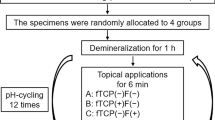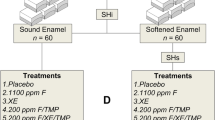Abstract
Aims: To evaluate and compare the efficacy of pea and halfpea portions of child formula fluoride (500ppm) toothpaste on artificially created enamel lesions in primary teeth. Methods: Sound primary incisors were painted with nail varnish, leaving a 1 mm wide window and then placed in a demineralising solution for 96 h to produce artificial carious lesions 60–100μm deep. The teeth were longitudinally sectioned (100μm thick) and divided into 3 groups. Group A: treated with a pea-sized portion of a non-fluoride containing toothpaste (1:3, toothpaste: deionized water), while Groups B and C were treated with half-pea-sized and pea-sized portions of a 500 ppm fluoride containing toothpaste, respectively. The pH-cycling model was utilized for 7 days. Results: Groups A and B lesions increased in depth by 60% while those in Group C increased by 19%. The mineral content of the surface zone decreased significantly in Groups A and B but not in Group C. Conclusion: Reduction of the amount of fluoride toothpaste to less than a pea-size in order to minimize the risk of fluorosis should be undertaken with caution because it may compromise the cariostatic effects of the toothpaste.
Similar content being viewed by others
References
Bentley EM, Ellwood RP, Davies RM. Fluoride ingestion from toothpaste by young children. Brit Dent J 1999;186:460–462.
Bloch-Zupan A. Is the fluoride concentration limit of 1,500 ppm in cosmetics (EU guideline) still up-to-date? Caries Res 2001;35(Suppl 1):22–25.
Burt BA. The changing patterns of systemic fluoride intake. J Dent Res 1992;71:1228–1237.
Davies GM, Worthington HV, Ellwood RP, Blinkhorn AS. An assessment of the cost effectiveness of a postal toothpaste programme to prevent caries among five-year-old children in the North West of England. Community Dent Health 2003;20(4):207–210.
Featherstone JD. Prevention and reversal of dental caries: role of low level fluoride. Community Dent Oral Epidemiol 1999;27:31–40.
Hara AT, Magalhaes CS, Serra MC, Rodrigues AL Jr. Cariostatic effect of fluoride-containing restorative systems associated with dentifrices on root dentin. J Dent 2002;30(5–6):205–212.
Heilman JR, Wefel JS, Pyrz JW. Development of a root caries pH cycling model. J Dent Res 1991;79:493.
Holt RD, Murray JJ. Developments in fluoride toothpastes—an overview. Community Dent Health 1997;14:4–10.
Itthagarun A, Wei SH, Wefel JS. Morphology of initial lesions of enamel treated with different commercial dentifrices using a pH cycling model: scanning electron microscopy observations. Int Dent J 1999;49(6):352–460.
Itthagarun A, Wei SH, Wefel JS. The effect of different commercial dentifrices on enamel lesion progression: an in vitro pH-cycling study. Int Dent J 2000;50(1):21–28.
Konig KG. New recommendations concerning the fluoride content of toddler toothpaste — consequences for systemic application of fluoride. Gesundheitswesen 2002;64:33–38.
Levy SM. Review of fluoride exposures and ingestion. Community Dent Oral Epidemiol 1994;2:173–180.
Levy SM, Kohout FJ, Kiritsy MC, Heilman JR, Wefel JS. Infants’ fluoride ingestion from water, supplements and dentifrice. J Am Dent Assoc 1995;126:1625–1632.
Levy SM, McGrady JA, Bhuridej P, et al. Factors affecting dentifrice use and ingestion among a sample of U.S. preschoolers. Pediatr Dent 2000;22:389–394.
Maltz M, Schoenardie AB, Carvalho JC. Dental caries and gingivitis in schoolchildren from the municipality of Porto Alegre, Brazil in 1975 and 1996. Clin Oral Invest 2001;5(3):199–204.
Marinho VC, Higgins JR Sheiham A, Logan S. Fluoride toothpastes for preventing dental caries in children and adolescents. Cochrane Database System Review 2003:CD002278.
Mendes FM, Nicolau J. Utilization of laser fluorescence to monitor caries lesions development in primary teeth. J Dent Child (Chic) 2004;71(2):139–142.
Paes Lerne AF, Tabchoury CR, Zero DT, Cury JA. Effect of fluoridated dentifrice and acidulated phosphate fluoride application on early artificial carious lesions. Am J Dent 2003;16(2):91–95.
Santaella MR, Braun A, Matson E, Frentzen M. Effect of diode laser and fluoride varnish on initial surface demineralisation of primary dentition enamel: an in vitro study. Int J Paediatr Dent 2004 14(3):199–203.
Sheiham A. Dietary effects on dental diseases. Public Health Nutr 2001;4:569–591.
Splieth C, Meyer G. Factors for changes of caries prevalence among adolescents in Germany. Eur J Oral Sci 1996;104:444–451.
Ten Cate JM, Duijsters PP. Alternating demineralization and remineralization of artificial enamel lesions. Caries Res 1982;16:201–210.
TenCate JM, Timmer K, Shariati M, Featherstone JD. Effect of timing of fluoride treatment on enamel de- and remineralization in vitro: a pH-cycling study. Caries Res 1988;22(1):20–26.
Thaveesangpanich P, Itthagarun A, King NM, Wefel JS, Tay FR. In vitro model for evaluating the effect of child formula toothpastes on artificial caries in primary dentition enamel. Am J Dent 2005;18(3):212–216.
Toumba KJ, Curzon ME. Fluoride concentration in saliva related to dental caries in primary teeth. Eur J Paed Dent 2001;2:15–19.
Wefel JS. Effects of fluoride on caries development and progression using intraoral models. J Dent Res 1990;69 Spec No: 626-633; discussion 634-626.
Author information
Authors and Affiliations
Corresponding author
Rights and permissions
About this article
Cite this article
Itthagarun, A., Thaveesangpanich, P., King, N.M. et al. Effects of different amounts of a low fluoride toothpaste on primary enamel lesion progression: a preliminary study using in vitro pH-cycling system. Eur Arch Paediatr Dent 8, 69–73 (2007). https://doi.org/10.1007/BF03262573
Published:
Issue Date:
DOI: https://doi.org/10.1007/BF03262573




